Saving Elijio Panti National Park from Wildfires
Wildfires continue to spread across the country and, over the weekend, personnel from the National Emergency Management Organization, NEMO, were deployed to southern and western Belize. In San Miguel, Toledo District, farmers fought the flames that were consuming their crops and did everything within their means to prevent the fires from spreading to homes and other structures in the village. In the west, a group of N.G.O.s led by the Association of Protected Areas Management Organizations, APAMO, took on fires that threatened the Elijio Panti National Park, as well as San Antonio Village. Tonight, we look at the efforts of brave residents and committed conservationists in Cayo District who were out over the weekend fighting wildfires. Here’s News Five’s Isani Cayetano with that story.
Isani Cayetano, Reporting
The threat of wildfires destroying the Elijio Panti National Park has prompted residents from nearby San Antonio Village, as well as responders from several environmental agencies, to join forces in a concerted effort to prevent the rapidly spreading flames from making their way into the protected area.
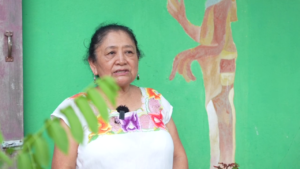
Maria Garcia
Maria Garcia, Chairlady, Itzamna Society
“The park is so important to us because it’s a corridor. It buffers the Macal River up Barton Creek. It’s a very fragile area. It’s, you know, part of our Mayan heritage, that’s where our people used to go and do their ceremonies. We go up there and collect our herbs, you know, it’s part of us.”
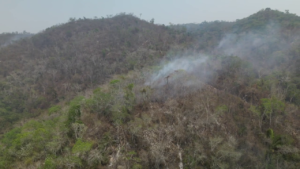 Cayo District is a vast expanse of wilderness that includes the Elijio Panti National Park, so named after the widely revered traditional healer. This large area of public land is protected by the Government of Belize for it scenic, recreational, scientific and historical importance. Here, many native plant and animal species are adapted to specific fire regimes, however, uncontrolled wildfires can harm or eliminate these species.
Cayo District is a vast expanse of wilderness that includes the Elijio Panti National Park, so named after the widely revered traditional healer. This large area of public land is protected by the Government of Belize for it scenic, recreational, scientific and historical importance. Here, many native plant and animal species are adapted to specific fire regimes, however, uncontrolled wildfires can harm or eliminate these species.
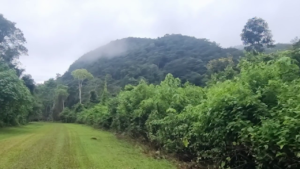 Maria Garcia
Maria Garcia
“It’s a unique area where we have waterfalls, we have the jaguars, we have howler monkeys, and, you know, the creeks feed into the Macal River. So if the park is destroyed there will be no more water to the Macal River.”
Over the weekend, quite a few teams were activated to fight the raging fires in Cayo District. The ecological impact of wildfires includes habitat destruction, soil degradation, and loss of native species. After a fire, invasive plants may colonize the burned areas, outcompeting native vegetation and altering ecosystem dynamics. Rene Tzib is one of several volunteers who have decided to join the effort.

Rene Tzib
Rene Tzib, Volunteer
“We went all around the hill which part is burning, we clear every branches that were on the line. So all the groups are working very hard right now, but we need some more water and like the heat right now is very hot. So they said they will leave it just like that, but it’s already controlled already, all around.”
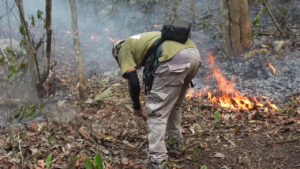 In western Belize, a combination of local wildfires and Saharan dust has led to poor air quality levels. Smoke inhalation can cause respiratory issues, chest discomfort and allergic reactions. San Antonio Village has roughly four thousand residents, vulnerable populations, such as children, the elderly, and those with pre-existing respiratory conditions, are particularly at risk.
In western Belize, a combination of local wildfires and Saharan dust has led to poor air quality levels. Smoke inhalation can cause respiratory issues, chest discomfort and allergic reactions. San Antonio Village has roughly four thousand residents, vulnerable populations, such as children, the elderly, and those with pre-existing respiratory conditions, are particularly at risk.

Andy Carrein
Andy Carrein, Belize Red Cross
“We are here in San Antonio Village, Cayo, helping, not really with the fires but making sure that people who have pulmonary issues aren’t suffering. So we are going house to house to check on them, check their vital signs and make sure they’re all doing well, make sure they have some facial masks to prevent any damage to their lungs from the smoke inhalation.”
Wildfires have far-reaching consequences, affecting both the environment and the well-being of communities. Urgent action is needed to prevent and manage wildfires effectively.
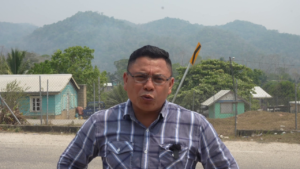
Aaron Tzib
Aaron Tzib, Chairman, San Antonio Village
“What we are facing at the moment here in the community is a fire threat. We have the white fires, if you see, it behind [me], to my rear. One week ago, we spotted some smoke up the hills and then from there it escalated and then it went out of control and that was the threat, like it was expanding towards the east where we had our water system pipelines.From the time we saw that the fire was expanding, we acted and we were proactive. We went there with the community members, we sought assistance, for help, and that is how we managed to open a track, a fire line all around the fire and we left the fire in the center. But we know that it’s very windy in the afternoons and in the evenings and that is how the fire just went out of control again because it went and it passed the fire line that we had already secured.”
As temperatures rise, dry conditions become more common, creating ideal circumstances for fire growth.
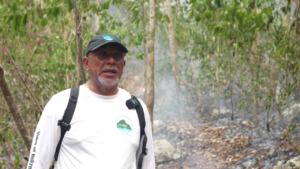
Jose Perez
Jose Perez, Executive Director, APAMO
“I must say, initially, that we are proud of the great work that our member, Itzamna Society, is doing in fighting this wildfire. Here, this is a testimony of the work that these groups have been doing over the years apart from deterring illegal hunting and illegal extraction of timber. Having eyes on the ground for incidents like these during the fire season, they are the first ones to notice these fires and activate a response. We have to thank NEMO and the prime minister for activating NEMO for this national response because it’s not only here that we’re having fires. We’re having fires all the way down south and in the north in the River Valley, but this one was given priority over yesterday and today because it was threatening a serious pipeline, a pipeline that runs all the way from the headwaters way down into the village, it provides potable water.”
Continued vigilance is crucial to mitigate the threats posed by wildfires, despite the ongoing emergency response efforts. Isani Cayetano for News Five.







Facebook Comments